Podczas konfigurowania witryny WordPress czasami ludzie przypadkowo tworzą swoją witrynę w folderze o nazwie „wordpress”. Może to spowodować, że adres witryny będzie wyglądał dziwnie, z „/wordpress/” w środku. Zamiast http://www.yoursite.com/, może wyglądać jak http://www.yoursite.com/wordpress/.
Przez lata wielu naszych czytelników pytało nas, jak poprawić ten problem. Posiadanie /wordpress/ w adresie strony może wyglądać nieprofesjonalnie i może dezorientować odwiedzających.
W tym artykule pokażę, jak usunąć /wordpress/ z adresu URL witryny, dzięki czemu adres witryny będzie wyglądał czysto i profesjonalnie oraz będzie łatwiejszy do zapamiętania.
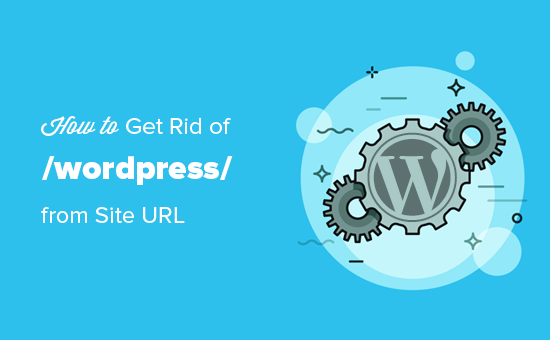
Uwaga: Metoda pokazana w tym poradniku działa również dla innych podkatalogów.
Dlaczego moja witryna internetowa ma adres URL /wordpress/?
WordPress jest dość łatwy w instalacji, a większość firm hostingowych WordPress oferuje szybkie instalatory WordPress w swoich panelach kontrolnych hostingu.
Jednak niektórzy początkujący, którzy instalują witrynę internetową WordPress ręcznie, mogą przypadkowo zainstalować ją w podkatalogu. Najczęściej podkatalog ten nosi nazwę „wordpress”.
Zwykle dzieje się tak, ponieważ użytkownicy przesyłają katalog wordpress, który znajdują w oficjalnym pliku do pobrania z WordPress.org.
Przyjrzyjmy się, jak łatwo to poprawić i pozbyć się /wordpress/ z adresu URL twojej witryny. Omówimy trzy metody i możesz użyć tych odnośników, aby przejść do tej, której chcesz użyć:
Metoda 1: Po prostu zacznij od nowa z nową instalacją WordPressa
Jeśli właśnie zainstalowałeś WordPress i na twojej witrynie internetowej nie ma treści, możesz po prostu zacząć od nowa.
Wystarczy usunąć obecną, aktualną instalację i postępować zgodnie z instrukcjami w naszym poradniku instalacji WordPress a, aby poprawnie zainstalować WordPressa ponownie.
Jeśli dodałeś już treść do swojej witryny internetowej, istnieją dwa proste sposoby na usuwanie /wordpress/ z adresu URL twojej witryny. Omówimy je w metodach 2 i 3.
Metoda 2: Zmień adres swojej witryny WordPress
Jeśli masz już witrynę WordPress, ta metoda jest łatwiejsza i szybsza. Wadą tej metody jest to, że twoje pliki multimedialne, takie jak obrazki, nadal będą używać /wordpress/ w adresie URL.
Najpierw musisz logować się do twojego obszaru administracyjnego WordPress i przejść do Ustawienia ” Ogólne. Zauważysz, że pola „Adres WordPress” i „Adres witryny” będą miały ten sam adres URL.
Musisz zmienić opcję „Adres witryny” i wskazać ją na twoją domenę główną, np. http://www. example.com i pozostawić opcję „Adres WordPress” bez zmian.
Gdy to zrobisz, kliknij przycisk „Zapisz zmiany”, aby zapisać twoje ustawienia.
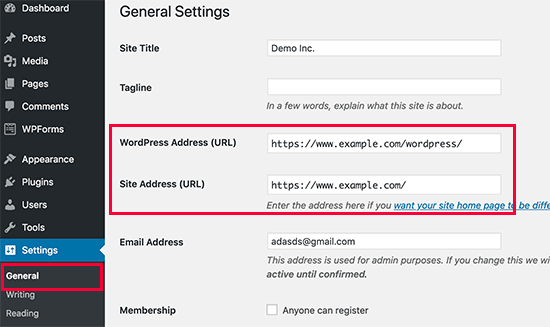
Następnie musisz połączyć się z twoją witryną internetową za pomocą klienta FTP. Następnie przejdź do katalogu /wordpress/ i pobierz pliki .htaccess i index. php na twój komputer.
Jeśli nie możesz zlokalizować pliku .htaccess, może być konieczne wymuszenie na twoim kliencie FTP pokazywania ukrytych plików. Jeśli korzystasz z Filezilla, musisz kliknąć Server na pasku menu i wybrać opcję „Wymuś pokazywanie ukrytych plików”.
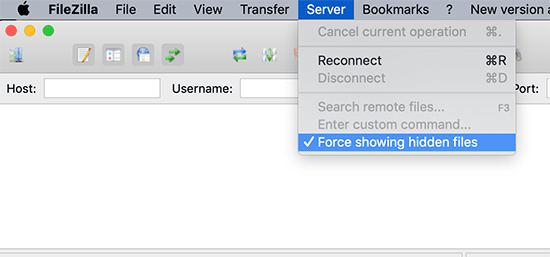
Po pobraniu obu plików na twój komputer, musisz otworzyć plik index. php w edytorze tekstu, takim jak Notatnik. W pliku tym znajduje się następujący wiersz:
1 | require( dirname( __FILE__ ) . '/wp-blog-header.php' ); |
Ta linia ładuje plik wp-blog-header.php, który jest wymagany do wczytywania twojej witryny WordPress.
To, co musisz teraz zrobić, to wpisz poprawną lokalizację pliku, zastępując istniejącą linię tą:
1 | require( dirname( __FILE__ ) . '/wordpress/wp-blog-header.php' ); |
Zapisz zmiany i prześlij pliki index.php i .htaccess z komputera stacjonarnego do katalogu głównego twojej domeny za pomocą FTP.
Folder nadrzędny to katalog, w którym znajduje się katalog „wordpress” i zwykle nazywa się /www/ lub /public_html/.
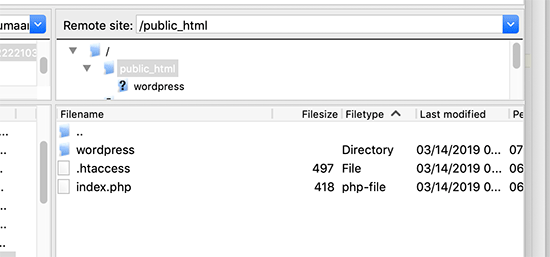
To wszystko. Możesz teraz przejść na twoją witrynę internetową za pomocą domeny głównej i wszystko będzie działać poprawnie.
1 | http://example.com |
Jeśli jednak musisz logować się do twojego administratora WordPress, to nadal będziesz musiał przejść do wp-admin wewnątrz katalogu „wordpress” w ten sposób:
1 | http://www.example.com/wordpress/wp-admin |
Metoda 3: Przenieś WordPress do katalogu głównego
Ta metoda jest bardziej kompleksowa i trwale przeniesie twoją witrynę internetową WordPress z podkatalogu do katalogu głównego witryny.
Krok 1: Utworzenie pakietu Duplicator
Najpierw należy zainstalować i aktywować darmową wtyczkę Duplicator na swojej stronie internetowej. Aby uzyskać więcej informacji, zobacz nasz przewodnik krok po kroku, jak zainstalować wtyczkę WordPress.
Uwaga: W tym poradniku będziemy korzystać z darmowej wersji programu Duplicator. Możesz jednak uaktualnić do Duplicator Pro, aby uzyskać nieograniczoną liczbę kopii zapasowych, zaplanowane kopie zapasowe, importowanie metodą „przeciągnij i upuść” i wiele więcej.
Po aktywacji należy odwiedzić stronę Duplicator ” Backups, a następnie kliknąć przycisk „Create New”.
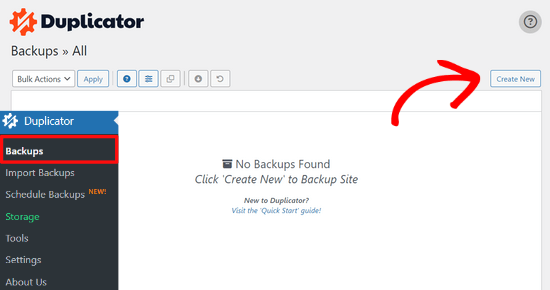
Spowoduje to uruchomienie kreatora Duplicator, który utworzy pakiet instalacyjny całej witryny.
Możesz dodać nazwę kopii zapasowej i kliknąć przycisk „Dalej”, aby kontynuować.

Następnie wtyczka wykona kilka skanów. Jeśli wszystko wygląda dobrze, możesz kliknąć przycisk „Build” u dołu.

Duplicator utworzy teraz pakiet i poprosi o jego pobranie wraz ze skryptem instalacyjnym.
Śmiało pobierz oba pliki na swój komputer, klikając przycisk „Pobierz oba pliki”.

Krok 2: Utworzenie nowej bazy danych dla świeżej instalacji WordPressa
Możesz użyć istniejącej bazy danych WordPress, ale lepiej jest utworzyć nową, aby twoja stara baza danych była bezpieczna i niezmieniona. W ten sposób możesz przywrócić twoją witrynę bez większego zamieszania, jeśli coś pójdzie nie tak.
Musisz przejść na kokpit cPanel twojego konta hostingowego, przewinąć w dół do sekcji „Bazy danych”, a następnie kliknąć ikonkę „Bazy danych MySQL”.

Następnie wystarczy podać nazwę twojej bazy danych.
Następnie należy kliknąć przycisk „Utwórz bazę danych”.

cPanel utworzy teraz nową bazę danych. Następnie należy przewinąć w dół do sekcji „Użytkownicy MySQL”.
W tym miejscu należy podać nazwę użytkownika i hasło dla twojego nowego użytkownika bazy danych i kliknąć przycisk „Utwórz użytkownika”.
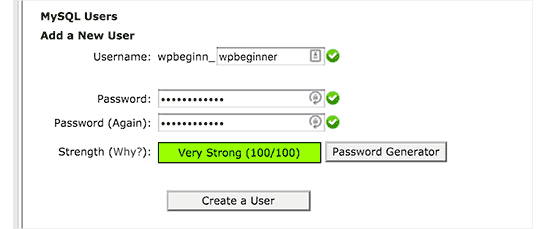
Teraz należy przypisać uprawnienia do bazy danych nowemu użytkownikowi.
Przewiń w dół do sekcji „Dodaj użytkownika do bazy danych”. Po prostu wybierz utworzonego użytkownika bazy danych z menu rozwijanego obok pola „Użytkownik”, a następnie wybierz bazę danych. Na koniec kliknij przycisk „Dodaj”.

Twoja nowa baza danych jest teraz gotowa do użycia w świeżej instalacji WordPress.
Krok 3: Uruchomienie kreatora Duplicator
Teraz musisz przesłać pakiet archiwum Duplicator i pobrany wcześniej plik instalatora do katalogu głównego twojej witryny internetowej.
Będzie to katalog zawierający folder/wordpress/.
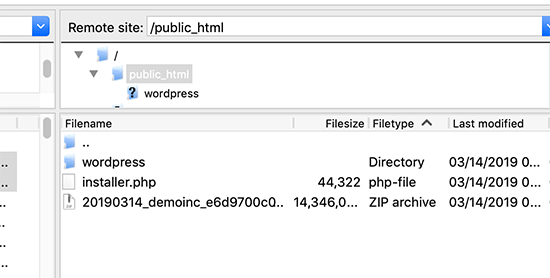
Po przesłaniu obu plików otwórz skrypt instalatora w oknie przeglądarki. Będziesz musiał wpisz główny adres URL twojej witryny, a następnie poprzedzić go /installer.php.
1 | https://example.com/installer.php |
Spowoduje to otwarcie kreatora instalacji programu Duplicator.
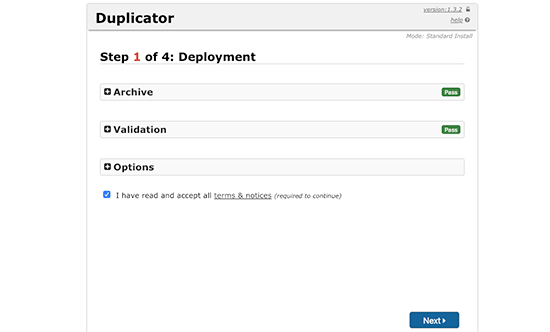
Zaznacz pole taksonomii, a następnie kliknij przycisk „Dalej”, aby kontynuować.
Następnie zostaniesz poproszony o podanie informacji o bazie danych. Wpisz informacje dotyczące bazy danych, którą utworzyliśmy wcześniej w kroku 2.
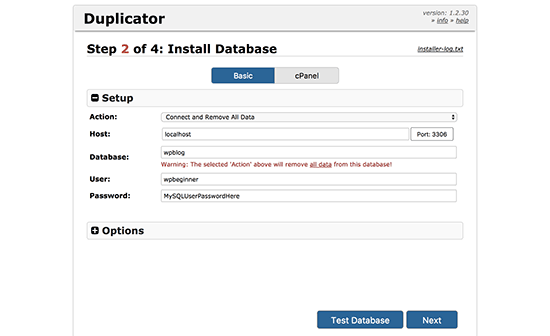
Po wpiszeniu informacji o bazie danych kliknij przycisk „Dalej”, aby kontynuować. Duplicator rozpakuje teraz twoją kopię zapasową bazy danych WordPress z archiwum do nowej bazy danych.
Następnie zostaniesz poproszony o zaktualizowanie adresu URL i ścieżki witryny. Nie musisz nic tutaj robić, ponieważ automatycznie wykryje nowy adres URL i ścieżkę. Jeśli jednak tak się nie stanie, możesz ręcznie wpisz dane tutaj.
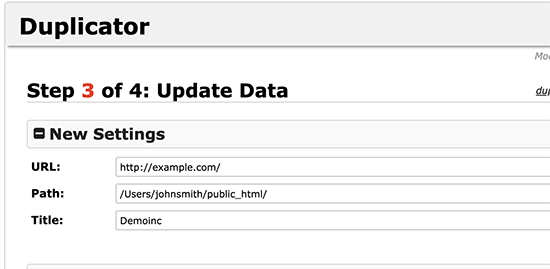
Duplicator zakończy teraz migrację.
Będziesz mógł kliknąć przycisk „Admin Login”, aby uzyskać dostęp do twojej witryny internetowej w nowej lokalizacji.
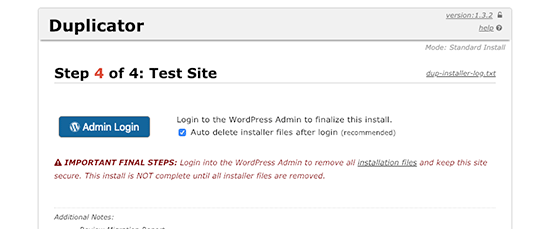
Krok 4: Konfiguracja przekierowań z podkatalogu do katalogu głównego
Gratulacje, udało ci się przenieść twoją witrynę WordPress z podkatalogu do katalogu głównego.
Teraz nadszedł czas na skonfigurowanie przekierowań, aby użytkownicy i wyszukiwarki mogli znaleźć nową lokalizację twojej witryny internetowej.
Najpierw musisz połączyć się z twoją witryną WordPress za pomocą klienta FTP, a następnie usunąć stary katalog /wordpress/.
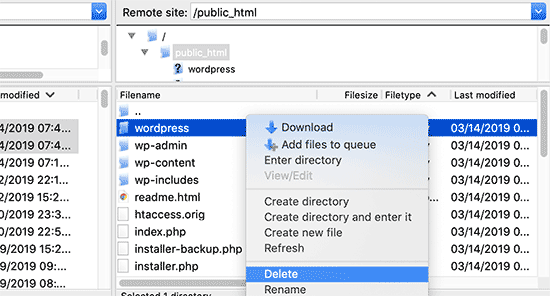
Następnie przejdź do obszaru administracyjnego twojej witryny WordPress. Ponieważ przeniosłeś go do katalogu głównego twojej witryny internetowej, adres URL administratora WordPress będzie wyglądał następująco:
1 | https://example.com/wp-admin |
Teraz należy zainstalować i włączyć wtyczkę Redirection. Aby uzyskać więcej informacji, zobacz nasz przewodnik krok po kroku, jak zainstalować wtyczkę WordPress.
Po włączaniu należy przejść na stronę Narzędzia ” Przekierowanie. Wtyczka wyświetli teraz kreator konfiguracji. Wystarczy kliknąć przycisk „Kontynuuj konfigurację”, a następnie „Zakończ konfigurację”.
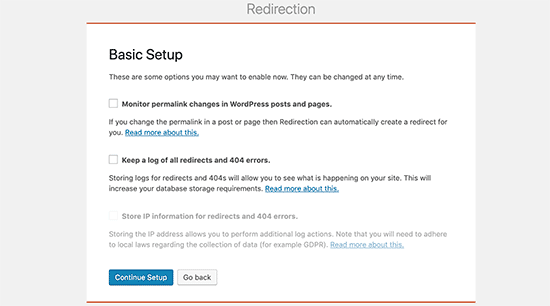
Następnie należy przejść do karty „Przekierowania” i utworzyć nowe przekierowanie.
Najpierw należy zaznaczyć pole „Regex” w rogu pierwszego pola.
Następnie przejdź do pola „Source URL” i dodaj https://example.com/wordpress/.*Następnieprzejdź do pola „Target URL” i dodaj https://example.com/$1.
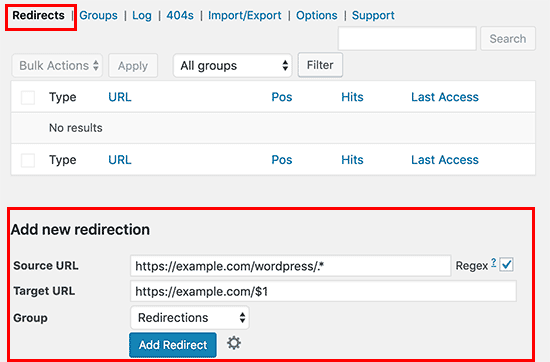
Nie zapomnij zastąpić „example.com” twoją własną nazwą domeny. Następnie kliknij przycisk „Dodaj przekierowanie”, aby zapisać twoje zmiany i gotowe.
Innym narzędziem do przekierowywania wpisów i stron jest All in One SEO (AIOSEO). Jak przekierować użytkowników korzystających ze starych adresów URL zawierających /wordpress/ do nowej lokalizacji twojej witryny, pokazujemy w naszym przewodniku dla początkujących na temat wykonywania pełnych przekierowań witryny w WordPress.
Ponadto można włączyć śledzenie błędów 404, aby wychwycić niedziałające odnośniki i nie stracić pozycji w rankingach słów kluczowych.
Od teraz wszyscy użytkownicy próbujący uzyskać dostęp do twojej witryny internetowej z /wordpress/ w adresie URL będą automatycznie przekierowywani do właściwych wpisów z twoim nowym głównym adresem URL.
Przewodniki ekspertów dotyczące zmiany adresów URL w WordPressie
Mamy nadzieję, że ten artykuł pomógł ci dowiedzieć się, jak pozbyć się /wordpress/ z adresu URL witryny WordPress. Możesz również zapoznać się z innymi przewodnikami dotyczącymi zmiany adresów URL w WordPress:
- Jak zmienić adres URL twojej witryny WordPress (krok po kroku)
- Jak łatwo zaktualizować adres URL podczas przenoszenia twojej witryny WordPress
- Jak usuwać cyfry z adresów URL WordPressa?
- Jak usuwać datę z adresów URL WordPressa?
- Jak usuwać ciąg v=XXXX z adresów URL WordPressa?
- Jak usunąć uproszczoną nazwę URL strony nadrzędnej z adresu URL strony podrzędnej w WordPress?
- Jak zmienić domyślny adres URL wyszukiwania w WordPress?
- Jak dodać własny adres URL logowania w WordPress (krok po kroku)
- Przewodnik dla początkujących: Jak znaleźć Twój adres URL logowania do WordPressa?
- Jak prawidłowo przenieść WordPress z HTTP na HTTPS (przewodnik dla początkujących)
If you liked this article, then please subscribe to our YouTube Channel for WordPress video tutorials. You can also find us on Twitter and Facebook.





Brenda
Thank you so much for this tutorial! So helpful.
I followed step #2 and all the pages on my site work now without the /wordpress in the URL, EXCEPT for the homepage. I updated the Site URL in Settings > General, but for some reason the homepage still redirects from mysite.com to mysite.com/wordpress.
Any idea why this might be happening? Thanks in advance!
WPBeginner Support
From the sound of the issue, we would recommend checking your index.php and htaccess are both in the correct folder for a likely reason.
Admin
Brenda
Thanks so much for your response. Figured out the issue!
WPBeginner Support
Glad to hear!
Adrian
Not sure if this related, on initial set up should you you use the www dot …. com or just your sitename dot… com
WPBeginner Support
That is a different situation that we cover in our guide below. WWW vs non-WWW is personal preference:
https://www.wpbeginner.com/beginners-guide/www-vs-non-www-which-is-better-for-wordpress-seo/
Admin
Lilly Walker
I followed Method 1: Change WordPress Site Address
changed the site address with out /mywpfolder
and downloaded the ht.access and the index file – (they dont match your eg but just added the /mywpfolder etc
and uploaded the htaccess and the index files back to the root directory
BUT
the correct front page came up and then clicked on a link it came up but clicked on a link then and it 404’d.
my guess is that some pages have urls manually put in but how do I search and replace these?
Alice K
Hi!
First, thank you very much!
I followed the second method, and now accessing the admin page works without adding „/wordpress” in the URL.
But when I try to access my website I still have to add „/wordpress” to the URL?!
Can anyone help? Where have I gone wrong?
WPBeginner Support
The site is likely active in the old location, you should should still be able to see your login if you go to yourdomain/wp-login.php
Admin
sginader
Thank you! I’m a WP novice so your step by step instructions was perfect. I do have a question – I followed Method 1 – does the redirect add to the site loading time? I ask because my site takes very long to load. Thank you!
WPBeginner Support
While it adds a small amount to the loading time, it shouldn’t add enough to be noticeable. If this increase in load time was recent then you may want to check with your host to ensure there isn’t something conflicting with the redirect you set up.
Admin
Nkosiyapha
This was very helpful. Thank you very much
WPBeginner Support
You’re welcome
Admin
Rachel
I have a question: if I use method 1, do I have to change all url links of my posts and images? My blog are actually inside a folder and I want to make a redirection to the root domain. It’s not clear…
WPBeginner Support
For the first method, you shouldn’t need to redirect your posts.
Admin
birgit van Munster
Hi, I made the change in the index.pho file as directed and moved the two files to the root directory, but I get this error message:
Parse error: syntax error, unexpected ” );’ (T_ENCAPSED_AND_WHITESPACE) in /data/40/5/47/114/5373603/user/6433782/htdocs/index.php on line 17
I think line 17 is exactly as described in the instructions, please help!
WPBeginner Support
You may want to ensure you copied the code correctly and pasted it on a new line. You may want to take a look at our article here: https://www.wpbeginner.com/beginners-guide/beginners-guide-to-pasting-snippets-from-the-web-into-wordpress/
Admin
Bella
Thank you so much! The guide I was reading didn’t mention the .htaccess part. This guide fixed the error on my site. Great work!
Bart
Hi!
Great tutorial, and my URL now redirects (woohoo!)
However when I go the settings tab and change the site title to the one without /wordpress, the site works fine except for the home page, which gives an error.
What am I missing here…?
TROP ICSU
Hi there!
I have my site hosted on my server. WordPress dir is located in /home/myuser/.
I tried to follow your steps by copying the updated index.php and .htaccess into same dir level where wordpress dir is. But no success.
Can you pl guide? Thank you.
Rachel
If I have a wordpress instance in a subdirectory and I just want to delete it and not move it, can I just delete the folder, or do I need to go through some kind of un-install procedure so it is removed from the database as well?
WPBeginner Support
Hi Rachel,
Yes you can delete it. However, we will still recommend to download it as a backup before deleting it.
Admin
Michael Hayman
Hey, so i had a go at this, and for some reason i am now faced with an HTTP 500 error.
Not sure where i went wrong, but i don’t seem to be able to get it back to normal.
Any ideas would be much appreciated.
I have tried resetting the index.php back to default as well as the .htacess file with no avail.
To make matters more difficult i get the same HTTP 500 message when trying to login to the wordpress admin as well.
Clarisse
Hi Michael,
My folder is called „/wp” instead of „/wordpress”, so probably yours too!
That might be the problem…
Louise
I had the same problem, and my folder was called wp. I just went back to the index.html file and changed it from wordpress to wp and problem solved! Such a helpful article, this was hanging over my head for months and so glad to have it fixed!
Gareth Botha
Hi Syed, many thanks for all these, I have been postponing my site for over a year now as it was simply too intimidating. I had however made the fault of installing wordpress to the subdomain /wp and set the entire site up. Just sorted it out with you tut above. I have however come across a new problem, my home/landing page no longer loads my blog posts. How do I resolved this? I also get a redirect error as well.
WPBeginner Support
Hi Gareth,
Good luck with your new website. Wish we could be more helpful, but it is up to the theme and your website settings. Please see our WordPress troubleshooting guide to figure out whats causing it.
Admin
Yan Xun
Hi, I followed these steps and my website is working fine. Only issue is now I can’t seem to load my theme’s UX Builder for my site.
does this method cause any issue if I am using a theme UX builder?
WPBeginner Support
Hi Yan Xun,
Here is what you can try. First create a backup of your website. After that Uninstall the UX builder by visiting the plugins page, now install and activate it again.
If it comes packaged with your theme, then again create a backup of your website. After that you need to download a fresh copy of your theme. Next, temporarily switch your WordPress site to a default WordPress theme like TwentySeventeen. Delete your old theme and then install it from the zip file you downloaded earlier.
Admin
Gina
Help! I followed your tutorial for removing wordpress. Now I can’t get into the site or admin.
Getting the following:
Warning: require(/home/content/09/8001609/html/wordpress/wp-blog-header.php) [function.require]: failed to open stream: No such file or directory in /home/content/09/8001609/html/index.php on line 17
Fatal error: require() [function.require]: Failed opening required '/home/content/09/8001609/html/wordpress/wp-blog-header.php’ (include_path=’.:/usr/local/php5/lib/php’) in /home/content/09/8001609/html/index.php on line 17
Marko
Done that, and '/wordpress’ from addressbar is gone, but Google still lists it with it in the search. For example:
WPBeginner Support
Hi Marko,
You will need to redirect those users. See our guide on how to setup redirects in WordPress.
Admin
Andrew
Thanks guys i love u <3
Priyanka
This tutorial is a life saviour. Thank you so much.
Beth
Thanks for your helpful website. I downloaded .htaccess and index.php. My index php says index.php4 The line on it says this: .htaccess disapears when I download it to the desktop. In ftp, they are located in the same folder as the wordpress1 folder is located. It appears to be the root directory. The site has the url with wordpress1 at the end of it. I’m not sure what to do, and don’t want to crash the site!
Thanks,
Beth
Lee Graham
Can I ask why you download .htaccess only to upload it again?, there is no mention of edting htaccess so why download in the first place ?
Brandi
I believe he’s asking us to download the one from the /wordpress/ subdirectory and then upload it to the / root (which is up one level). I hope that helps
Manpreet Kaur
HI,
Thankyou so much for these helpful tutorials my one problem is solved but there is one another. When I search on google and type my website address it shows index of link instead of my website name. When I click on that link it opens my website. Can anyone help me to display my website URL on google instead of index of URL.
Ariadne1985
THANK YOU SO MUCH!!!
I spent hours working on it (failure) and then found your site + explanation.
SUPERB!
Filip Kevely
1. I have moved my example.com WP installation into subfolder (let’s call it „secret-sub”).
2. Typing example.com/wp-login.php automatically re-directs me to example.com/secret-sub/wp-login.php :((
((Note: Visiting no other part of my web page shows this subfolder name as part of URL address; visitors see only example.com everywhere.))
Is this normal behaviour?
And if so – what’s actually the point of having your WP installation in „secret” subfolder – when basic /wp-login.php and /wp-admin brute attack re-directs to URL showing the „secret subfolder” name??
Any clear explanation will be very much appreciated. Thx.
WPBeginner Support
Hi Filip Kevely,
When you install another WordPress instance in a sub-folder it creates a conflict for WordPress permalinks. To fix that you need to add this code to your sub-folder site’s .htaccess file:
# BEGIN WordPress<IfModule mod_rewrite.c>RewriteEngine OnRewriteBase /secret-sub/RewriteRule ^index\.php$ – [L]RewriteCond %{REQUEST_FILENAME} !-fRewriteCond %{REQUEST_FILENAME} !-dRewriteRule . /secret-sub/index.php [L]</IfModule>#ENDWordPress1-click Use in WordPress
Don’t forget to replace secret-sub with the actual subfolder name.
Admin
Charlotte Tomic
How do you get rid of FEATURED CONTENT on your blog? I eliminated footers without a problem, but can’t get rid of featured content showing up on the blog front page.
Jade
Hi there, I am pulling my hair out…….I dont have the wordpress address url or the Site Address url under settings general! I have one site with nothing on it with my web address and then another site which I have fixed up with the same name but then wordpress.com at the end, any help would be greatly appreciated.
Arif
I have followed given the instruction but I am facing problem my website is not open correct and wp login penal is not coming please help me quickly.
Bright Bernard
Hello,
I successfully got rid of /wordpress from site URL following the instructions in the tutorial but once i installed yoast for seo , google shows the pages with /worpress in its search results.how can we remove that from google search results also?
Blane
Thank you! This works great!
Kala
Please help, I thought I had followed the steps correctly but am receiving this error when I type in my web domain:
Fatal error: require() [function.require]: Failed opening required '/home/melanieh/public_html/wordpress/wp-blog-header.php’ (include_path=’.:/usr/lib/php:/usr/local/lib/php’) in /home/melanieh/public_html/index.php on line 17
What did I do wrong?
Robel
Thank you man this work after so many hard work. Thanks again keep it up…..will come here for wordpress problem
Julius Decada
problem with 404, I resolve it in a longest manner, First I just open the post and click update, it works,.. although if you got a thousand post then you grow beard before you finish everything,..
second solution
another solution, although i never test this type of solutions in my active sites,
1. first thing first back-up your wordpress website,
2. when back-up is done, got to tools and click export, it will create xml file
3. delete all post,..
4. Import the xml file that you exported,. and and everythng go smoothly,..
Rodrigo Henriques
Thank you for the great tutorial. Worked perfectly!
rio
everything worked except my root domain name.
when I go to mydomain.com I get a 500 error, but all my links mydomain.com/contact mydomain.com/links look fie
Rodrigo Henriques
Hi,
have you checked if you REALLY have a „yourdomain/wordpress” directory?
Or a „yourdomain/wp” directory!
Because if you do you have to change the index.php editing accordingly ; )
Hope that helps,, it worked for me ; )
Marko Vojnovic
THANK YOU SO MUCH!!!!!!!
omkar
how to check whether i have a /wordpress or a /wp directory? and what following changes should i make then in the index.php file?
Tammie Radikopf
Thank you for this reply!! Your answer is what helped me solve my problem. I didn’t realize you couldn’t just use 'wordpress’ as the tutorial said but needed to use the exact subdirectory name. it worked. Thanks!!
Vernon Harris
I was moving our word press site from the root folder to a sub folder and everything almost worked. The only exception was that I couldn’t find a way to remove the sub-folder from the domain URL. This site had the easiest instructions and was easy to follow. It worked perfectly the 1st time. Thank You!
WPBeginner Support
Hi Vernon,
Glad you found it helpful Don’t forget to join us on Twitter for more WordPress tips and tutorials.
Don’t forget to join us on Twitter for more WordPress tips and tutorials.
Admin
rio
I followed the steps but now my website page isn’t working. And I cannot open my wordpress admin page either. Help?
Fadiah Karim
I followed the steps but now my website page isn’t working. And I cannot open my wordpress admin page either. Help?
Dan Kemble
You say upload the ht access file but you never say how to edit it?
Alexandra
I never leave comments but this post was just so clear and helpful that I have to say THANK YOU!!! :-)))
WPBeginner Support
Hi Alexandra,
Thanks, we are glad you found it helpful. Don’t forget to join us on Twitter for more WordPress tips and tutorials.
Admin